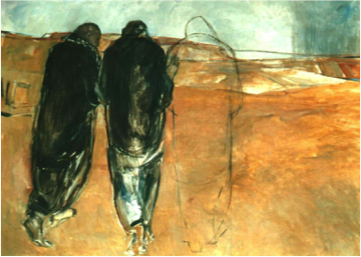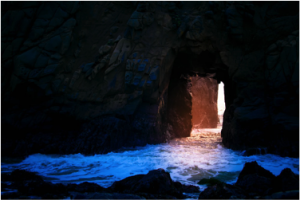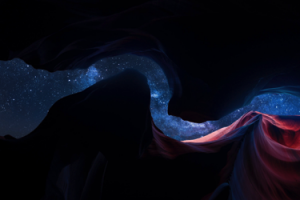Contributed by Laura Ruth
How wonderful, that, here we are, discussing “Chapter Nine: The Passion,” “Chapter Ten: The Crucifixion and Its Aftermath,” and “Chapter Eleven: The Great Easter Fast” in The Wisdom Jesus by Cynthia Bourgeault. How poignant to be leaning into her writing about Holy Week and the fifty days following Easter—in the thick of it, right now. Ascension, May 13th, and Pentecost, yet to come. We remain. Abide in this quiet thin time of the year when the resurrected Jesus walked the earth visiting and teaching before his final departure as embodied form. Forty days, then ten. Time to pause, to hear what is waiting to come into birth from the absolute depths of us.
Beginning with “the Passion as really the mysteries of all mysteries, the heart of the Christian faith experience (pg. 104), Cynthia walks us through the last days and death of Jesus with fresh eyes. In freely accepting his short and intense life, Jesus en-courages us to “make the passage into unitive life”:
…both modeling and consecrating the eye of the needle that each one of us must personally pass through in order to accomplish the ‘one thing necessary’ here, according to his teaching: to die to self…to grow beyond the survival instincts of the animal brain and egoic operating system into the kenotic joy and generosity of full human personhood…a sacred path of liberation.” (pg. 106)
Holy Week has been a mystery for me for a long time. Rather than succumbing to the angry God, or the guilt that we killed Jesus by being bad and wrong, I was touched as a child by a deep feeling for the words and stories of the Bible and fed upon them as close Friends. Jesus, Mary, and Mary Magdalene were companions in the secret places of my being. Instead of blame or scapegoating, I nursed a sense of mysterious truth and love at the heart of Holy Week, that literally nourished me. That feeling has not died or diminished within, though I have not “understood” it.
Cynthia covers much of the traditional territories of Holy Week, and applies a healing balm with her own affirmation experience of the “indwelling love.” She takes us to John where “Jesus will allow no separation between God and humans, no separation between humans and humans, because the sap flowing through everything is love itself” (109). Assuring his people of a new intimacy, and a greater capacity dawning within, Jesus is preparing his students for the time when they too may say: Yes, Let It Be, and Thy Will Be Done.
There is hope here, faith in this life, in us. We cannot truly utter these potent words without entering into a partnership, an enjoining that is complete if it is sincere. Jesus shows us that there is no other way these words can be actually embraced—they are indeed a wholly embodied declaration of becoming-part-of, of giving the self—not away—but into a greater Beingness. Cynthia ends her chapter on the Passion with the creative, “cosmic sowing of a seed from which will spring forth that impossible livable, the bush that burns but is not consumed” (pg. 112).
I sense a poignant beauty in Holy Week, undeniable but not graspable by the mind. The terror of what we humans are capable of lives right beside love and goodness; we witness both the strength and the weakness of us. The descent of the human-divine into the very heart of matter brings such joy and trembling; for some, an urge to accompany, to sit with the forces in the depths of us and bear witness. Is this not how we love? What we do? Cynthia speaks of this sacred well, recalling us to “the jagged, binary nature of this realm of existence” as home to:
…the precise conditions required to make possible a particular kind of divine self-disclosure. Only at this particular density, within these sharp edges and term limits (the ultimate one, of course, being death), do the conditions become perfect for the expression of the most tender and vulnerable aspects of divine love.
What moves us to destroy, to separate, to take apart? What is operating in us at the poles of life-denying and life-giving? Our personal work with these parts of self is an offering to the Whole. To accept, untangle, relax our grasp. To feel love surge out of the absence of love: this is what the mystical traditions have always said is our “uniquely important contribution to the divine fullness” (pg. 120).
How close this all is to our humanness! To the heart. It is a recognition event—we keep circling back to recognition as a force—the re-membering surfacing, running underground, breaking through again. We see this story all around us, and we know it in ourselves. The whole of it. We know both the ragged emptiness and the abundant fullness, and we have been in some measure with each. Remember the emphasis Cynthia gave in The Meaning of Mary Magdalene to the reality that Jesus was not alone, not forsaken, but continually tracked and witnessed. Alone, and yet in relationship. Loved. A great mystery. We fall asleep, we wake up, garner presence, fall asleep again. We are alone, we are held.
Here in Wisdom Jesus she quotes Annie Dillard’s Pilgrim at Tinker Creek, another deeply archetypal yet absolutely earth-bound and therefore resounding witness to the very nature of life in all its riotous, wild beauty and horror right in the center of creation—from the human-God to the insect, we are embedded in a web of life and death on so many levels. Can we take our part? As we are guided to navigate our relationship with the dualities of this sphere, in and outside of us, we are not alone, we cannot deny What Is, we are embedded within this life and we are not only that. Cynthia says at the close of Chapter Ten:
In those deeply hidden hours of Holy Saturday we find Jesus going to the root of that duality, embracing it, sheathing it in a greater love that will hold it firmly in place under the dominion of that love, and in obedience to the love, if we simply allow the kenotic path to take its course. With that guarantee in place, we can follow where he has gone. (pg. 124)
How do we live these archetypal realities that lace through life? We are here, now, in another forty days, in what Cynthia calls the Easter Fast. We just had Lent! Forty days has been traditionally a time of transformation, of shedding what no longer serves and the slow arising of what is new, a time of purification and preparation, of grounding what is coming to birth before rejoining the world anew. Time to stop. Open our ears and polish the mirror of our hearts. How to walk the spiral of a second forty days. Quiet our beings. Easter’s true nature sets us back upon the earth gently, carefully, in these our days and times, where the “invitation” is to “Come and see,” to “encounter the Wisdom Jesus.”
We are in the Mystical Body, revisited perhaps by that subtle power of recognition, the possibility to trust what makes itself manifest. A knowing that lives deep within and beyond ourselves, in that gorgeous paradox of the personal and the universal; inside of which we do not know more—but our knowing is deeper (pg. 137). A transparency that we cannot touch in ourselves alone because it moves in a dynamic field of living relationship that crosses boundaries and realms both within and beyond our wee selves. In this season, perhaps more potently, we sense that aliveness and intimacy: “That Jesus, the living master, is real, alive, intimately and vibrantly enfolding you right now. He is more present, in fact, than even your breath and heartbeat” (pg. 136).
What good fortune that we meet in the very midst of what Cynthia calls, “these exquisitely turbo charged days” (pg. 126). Alert for what is alive and trembling with truth in the undercurrents of our lives, to sense a Greater Beingness all about us, to allow ourselves to open to the Mystical Body within us as a collective, to be teachable in this thin space:
that during these great fifty days of Easter, the same invitation is extended to each one of us: to catch the drift of what Jesus is really inviting us to and to deepen our capacity to receive the intense spiritual energy available to us during this sacred season as a catapult to our own transformation” (pg. 126).
I began writing this on April 22, 2021, Earth Day. Our planet, beautiful mother of life, that is part of us as we are part of her, that we have ravaged and abused, loved and cherished, been given bodies by. Receive our human journey ground. May we learn to walk, to live, our gratitude! I hear the call to open the ear of my heart during these forty days, and turn, perhaps, with an ever deeper riveted attention to the deeply mysterious chasm-space in the ten days that follow. To spend some quiet moments with the possibility—so alive to the mystics—that Jesus sits at the root of the root:
a ‘pan-cosmic’ saturation of his being into the deepest marrow of this created world… without in any way denying or overriding the conditions of this earth place, he is interpenetrating them fully, infusing them with his own interior spaciousness, and inviting us all into this invisible but profoundly coherent energetic field so that we may live as one body” (pg. 134).
What follows in The Wisdom Jesus are the chapters on praxis. I sit with this today, a day, as all days, when many woes, angers and sorrows, much that remains unresolved, is being marked by our fellow humans. I open to the voices of the Virtual Prayer Tent rising as the people of Minneapolis gather in mourning and hope, am aware of the wails and songs of an online vigil for the Sikh community, suffering from hate-crime, another mass shooting. I sit with these and feel joy with the flowers blooming again in the northern hemisphere, the bird song, the children. I am with people engaged in practices designed to bring us deeper into our three centers of movement, feeling and thinking. Grounding in visceral sensation in the body, we touch the Presence that is alive, always, within us. Hope to offer a breathing companionship and witness to what is broken, what is hurting, to what struggles in us humans. We learn to center and ground in the silent prayer of letting go. To welcome without judging, grasping or rejecting What Is. To gather with the collective in the psalms and touch the ineffable through chant, to Be with sacred text. We hone and practice, grow resiliency and forbearance.
Each of us drawn to this path seems to be working towards more deeply connecting and growing being. I pray that we be strengthened and led to open with compassion to the whole of the world, bear ever greater witness, work on what separates us from ourselves, one another, the whole. I pray that we may face ourselves, the brokenness that is part and parcel of being human, without judgement. May we heal. Learn to track the depths and crevices and nature of love. Take this work into our daily life, and let it work its will with us. Follow more truly and receive the path of being-with and turning-toward that has been carved out for us, resisting the urge to deny, run or turn away.
Walking the jagged byways of this realm with our hearts open, may we meet this ‘pan-cosmic saturation of Being in our deepest marrow’ and in the Whole.
Images from the top: Road to Emmaus, courtesy of the Vatican News; East Wall, She is the Burning Bush itself: mural artist Seraphim O’Keefe, courtesy of Orthodox Arts Journal, Murals for the Burning Bush Chapel and Prothesis at St John of the Ladder in Greenville, South Carolina; Exploring the Cave, image courtesy of Ivana Cajina, Unsplash; Light Keyhole, image courtesy of Leon Lee, Unsplash; Lower Antelope, courtesy of Ameer Basheer, Unsplash.
Wisdom Jesus Book Circle
A monthly series of resources from the friends and leaders of the Wisdom Waypoints Book Circle Series on: The Wisdom Jesus: Transforming Heart and Mind—A New Perspective on Christ and His message by Cynthia Bourgeault.







